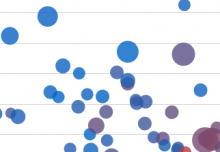![]() Most media attention is on consumer-oriented applications, social and e-commerce ones. But here we are discussing web-based reporting software that allows employees to access mission-critical or time-sensitive data while whenever and wherever needed.
Most media attention is on consumer-oriented applications, social and e-commerce ones. But here we are discussing web-based reporting software that allows employees to access mission-critical or time-sensitive data while whenever and wherever needed.
As we have already discussed the advantages of web-based reporting software and BI analytics tools, it is time to understand how these solutions will impact your business positively. You must be aware of what the software solution brings to the table, its features and capabilities.
To read the earlier related article, click Why Go for Web-Based Reporting Tools?
Web-Based Reporting Software’s Features and Capabilities
Web-based reporting software brings plenty of things to the table, some of which are discussed below.
Business Logic Implanting
- JavaScript is used for report, page, and element level scripting
- There’s limited control over element visibility and page break
- Exceptions or business-rule triggers are handled timely with warnings
- Details in the background and foreground are aptly highlighted
Regarding Data Access
- Provide connectivity to relational databases (JDBC), multidimensional databases, SOAP, Big Data sources including Hadoop, ERP applications, Microsoft Excel, XML, and flat files.
- Makes available data mashup from multi-source data objects
- Provides excellent data cell level security control
High-Performance and Scalability
- There’s a provision to configure data and report data caching
- Report servers can be easily clustered
- File systems and database updates are managed accurately
- Provides data access connection pools
- Allows data and page streaming
- Easy-viewing of the running of concurrent reports
About Production Report Design
- Users get to work on dynamic expanding table and super crosstabs
- Offers word processor-like and HTML-like layout designer
- Advanced presentation options using TOC, maps, images
- There’s provision for sub-report nesting
- Boasts of rich presentation element library
- Meta templates and report beans can be reused
- Has multi-lingual capability; thus supports international languages
In Regards to Interactive Report Viewing
- Supports mobile reporting to make it accessible from Android-based tablets, smartphones, along with iPads, and iPhones
- Reports can be viewed in real-time
- Filtering using text fields, drop-down lists, and other form controls
- Supports all types of web browsers – Chrome, Internet Explorer, Firefox, Safari
- Options to export reports to Excel, PDF, and CSV
- Easy to switch between summary and detail displays
- Provision to sort, filter, hide/unhide data within the report
- Access to archived reports
Concerning Enterprise Environment
- Data cells, reports and folders have high-security control
- Users can search through report metadata
- There’s support for HTTPS as well as encryption on PDF outputs
- There is provision for archiving and versioning
- Audit, access, and error logs are available for easy management
- Security is offered on the basis of individual and functional module
Embedding and Integration
- There’s provision for using a Java-like API for data and report manipulation
- Supports IIS and MS Share Point
- Provides CSS driven presentation customization
- There’s JSP tag library to assist in presentation
- Supports web service and SOAP architecture
Wrapping Up
As you see, web-based reporting software brings several features that can benefit your business in various ways. So, we, of course, encourage you to invest in these software solutions for easy reporting and analysis for better decisions.




